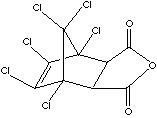PRODUCT IDENTIFICATION

H.S. CODE
TOXICITY
CLASSIFICATION
CARBOXYLIC ACID ANHYDRIDES / FLAME RETARDANTS
PHYSICAL AND CHEMICAL PROPERTIES
MELTING POINT
SOLUBILITY IN WATER
AUTOIGNITION
NFPA RATINGS
REFRACTIVE INDEX
APPLICATIONS
Chlorendic anhydride is characterized by the structure of chlorinated bicyclic and difunctional anhydride. It is useful in fire and corrosion resistances and UV stability for alkyd resins, polyurethanes, polyesters and epoxy resins.
APPEARANCE
PURITY
99.0% min
Cl CONTENT
57.0% min
8 (Packing group : II)
OTHER INFORMATION
Flame Retardant are substances that can be chemically inserted into the polymer molecule or be phisically blended in polymers after polymerization to suppress, reduce, delay or modify the propagation of a flame through a plastic materials. There are several classes of flame retardants Halogenated Hydrocarbons (Chlorine and Bromine containing compounds and reactive flame retardants), Inorganic flame retardants ( Boron compounds, Antimony oxides, Aluminium Hydroxide, molybdenum compounds, zinc and magnesium oxides ), Phosphorous containing compounds (Organic phosphate esters, phosphates, halogenated phosphorus compounds and inorganic phosphorus containing salts).
Class of Flame Retardants
- Inorganic
- Metal hydroxides
- Aluminium hydroxide
- Magnesium hydroxide
- Orthers
- Antimony compounds
- Antimony trioxide
- antimony pentoxide
- Sodium antimonate
- Others
- Boron compounds
- Boric acid
- Borax
- Zinc borate
- Others
- Other metal compounds
- Molybdenum compounds
- Titanium compounds
- Zirconium compounds
- Zinc compounds
- Zinc stannate
- Zinc hydroxy-stannate
- Others
- Others
- Phosphorus compounds
- Red phosphorus
- Ammonium polyphosphate
- Others
- Other inorganic flame retardants
- ammonium sulfamate
- ammonium bromide
- Others
- Halogenated organic
- Brominated
- Tetrabromobisphenol A
- Decabromodiphenyl ether
- Octabromobiphenyl ether
- Tetrabromobiphenyl ether
- Hexabromocyclododecane
- Tribromophenol
- Bis(tribromophenoxy) ethane
- Tetrabromobisphenol A polycarbonate oligomers
- Tetrabromobisphenol A epoxy oligomers
- Others
- Chlorinated
- Chlorinated paraffins
- Bis(hexachlorocyclopentadieno)cyclo-octane
- Others
- Organophosphoros
- Non-halogenated compounds
- phosphate esters
- Ttrialkyl phosphates
- Triaryl phosphates
- Aryl-alkyl phosphates
- Others
- polyols
- phosphonium derivatives
- phosphonates
- Others
- Halogenated phosphates
- Tris(1-chloro- 2-propyl) phosphate
- Tris(2-chloroethyl) phosphate
- Tris(2,3-dibromopropyl)phosphate
- Others
- Nitrogen-based
- Polyurethanes
- Polyamides
- Melamine and its salts
- Guanidine compounds
- Others